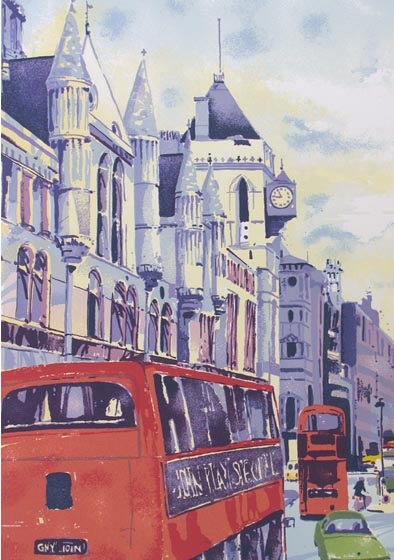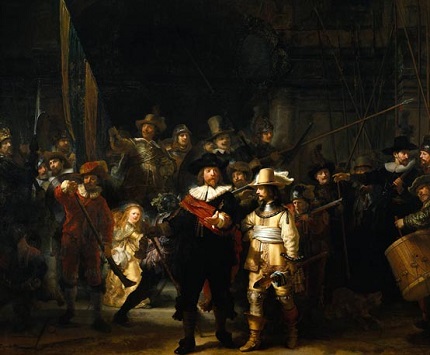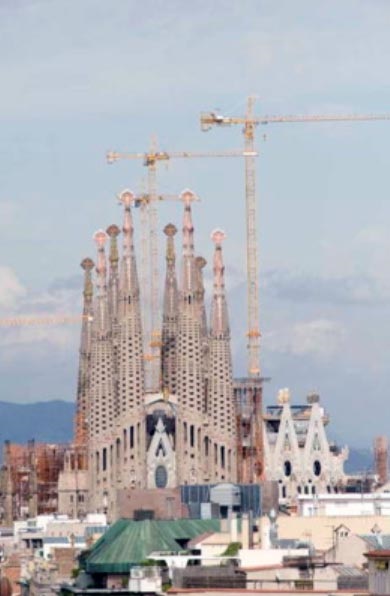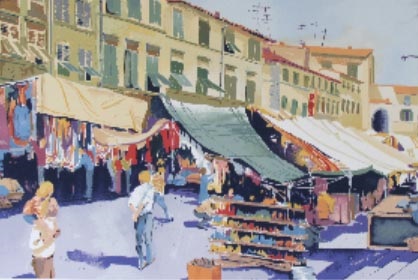
| Print | Back |  |
August 19, 2013 |
 |
Moments in Art Along Our Questing Pathsby Lawrence Jeppson |
I was 55 when I went gallivanting around Europe with a two-month Eurail pass and an official document certifying that I was a university student entitled to free or reduced-price student tickets to museums like the Louvre.
I didn’t gallivant alone.
Between her junior and senior years at Brigham Young University, my daughter Anne wanted to spend four weeks in Europe with other art students visiting museums and sketching under the tutelage of a teacher from the fine arts department. The teacher was the incomparable James Christensen!
Jim was the perfect choice to lead, teach, and inspire these eager art students. Now, several decades later, his fantasy art has made him the most successful and best-known artist in Utah. (I will write about him in a future column.)
I asked Anne if I could go with them. Jim said I would be welcome, if I paid what the students were paying. Fortunately, I was not expected to sketch. But like the 14 young artists, I did get an international student identity card.
Thus began a string of little adventures, moments in art. Although the group was scheduled to be in Europe for a month, Anne and I were planning to stay for two, finances permitting.
The first stop for the group was London. From England we would go to Amsterdam, Paris, Madrid, Florence, Venice, and back to London, with some side trips and stops. Jim had taken previous student groups to these places and knew them well, and he had a lot of smart tips for travelers, such as using a passport holder that hangs around the neck and is concealed by clothing.
Unfortunately, this tip came too late for a girl who lost her passport from her purse to a Paris Metro pickpocket. This created serious challenges — another of our mini-adventures — to get her a new passport before the group left for Madrid.
In the course of things my own experience in Europe proved to be helpful, and I became a grandfather addition to the group. As we went along, Jim carried the money, made lodging and travel arrangements, bought tickets, paid the hotels and restaurant bills. He was a genius in keeping things organized, talking about the pictures he wanted us to see in museums, and setting his students down for periods of sketching and learning.
Although the others would depart from Utah, Anne and I were in Maryland and would join the group in London. We decided to go a few days earlier and see many of the things that the others weren’t scheduled to see until they returned to London at the end, which we did not intend to do. We booked into the same hotel where everyone would stay.

My first contribution: since the group would visit the big museums upon their return to London, I suggested to Jim that they might like a short trip south of London to the Dulwich Picture Gallery. Dulwich, opened in 1817, claims to be the earliest public picture gallery in England. Some expand that claim to the whole of Europe.
Because of the collecting by its founders and bequests of varying sizes, Dulwich possesses one of England’s finest collections of old masters, especially Dutch, English, and French. In 1966, eight of these masterpieces, including three by Rembrandt and three by Rubens, were stolen. Superior detective work led to their recovery a few days later.
Dulwich’s small Rembrandt portrait, Jacob de Gheyn III, has been swiped and recovered four times (a future column) and is listed by the Guinness Book of Records as the most frequently stolen painting.
We crossed the English Channel to Holland, spent a day or two in Amsterdam seeing Rembrandt’s Night Watch and other masterpieces in the Rijksmuseum and the city before taking a train to Paris.

Does any city have more museums, big and little, than Paris? Everyone knows about the Louvre, but not so many have heard of the Marmitton, which shows the Claude Monet paintings left to his son, or the small Rodin, Bourdelle, or Bonnard museums. The new Pompidou museum of modern art was in full steam. The Picasso Museum had not been created, and the d’Orsay was still a defunct railway station.
Because I knew large parts of the art community in Paris, I could make a unique contribution to our group. I took them to meet Nat Leeb, whom I consider one of the two finest French colorists of the 20th century. (The other is Matisse; they are not a bit alike.)
We spent an inspirational two hours in the big room of Nat’s townhouse while he talked about art, being a painter, and answering lots of questions. Appropriately, the home was on a narrow, dead end street called Villa Seurat.
Madrid brought the obligatory visits to the Velasquez and Goya collections in the Prado, time spent in Retiro Park for sketching, and a night at a bullfight. We made a side trip to see the El Greco masterpieces in Toledo, where many of us purchased medieval illuminated antiphonary pages taken from large monastery songbooks. Not yet in existence was Madrid’s Queen Sophia Center (a future column), which would become, when opened, arguably the largest museum of modern art in the world.
Headed towards Italy, we had a long stopover in Barcelona so that we could gape over the still-unfinished Gaudi cathedral, often the subject of PBS programs and Rick Steve’s Europe.

The plan in Barcelona was to put our baggage in train station lockers while we did our explorations. Another little adventure. Because of government fears for bombs that might be planted by Basque separatists, all the lockers had been removed. Always resourceful, Jim found a nearby hotel that agreed to rent a guest room where we could dump our luggage.
Florence was a treasure house of Renaissance art. So much for young artists to see, from the Uffizi Museum, Michelangelo’s David, the cathedral, the beautiful park high above the city. The great open market was equally impressive. Jim had a favorite and trusted vendor of leather products. I purchased a billfold that after more than 30 years of near daily use shows little sign of wearing out. Maybe that’s because there is never much money in it.

We had a day trip to Rome. Although St. Peter’s remains overwhelming in its scope and beauty, my most awe-inspiring building is the nearly 2000-year-old domed Pantheon. I am overwhelmed by the architectural achievement so long, long ago — and the fact that it survived.
Arriving in Venice, Jim sent out a scout to find us an inexpensive hotel near the rail station and away from the high-price tourist areas. When we had some free time, I was eager to find the old scuola and show Anne, my youngest daughter, the work of Vittorio Carpaccio (1460?-1525/6).
As I wrote in an earlier column, Marian, my oldest daughter, and I had been in Venice with Paris dealer Pierre Domec to see the famous Biennial. He took us to see the Carpaccio masterpieces. I wasn’t sure I would be able to find them again, but Anne, Laura Lee Stay, and I did.
Like the rest of the students, throughout the four weeks Anne did a lot of sketching and took rolls of pictures. After the trip she would turn many of these into watercolors. I called the sequence “Along My Questing Path.” I published four of them as fine, limited-edition silkscreen prints.
When the rest of the group headed back to London, Anne, another girl, and I parted and went in a different direction, north to Vienna. (Next week’s adventures.)
There were many high points to these weeks with James Christensen and his pack of talented art students, who allowed a middle-aged man to tag along. I helped when I could, shared what I knew, and tried not to interfere.
One of my most cherished memories came just after we sat down to dinner in an inexpensive, off-the-beaten-path restaurant in Venice. The food proved to be succulent.
The menu, of course, was in Italian, and the people in this restaurant didn’t speak a whole lot of English. I could figure out enough Italian to know that one of the choices was “all the fruit of the sea.” Venice, on the sea — what could be more appropriate? The selection probably would include a few strange things typical of the location.
That was my choice.
As the waiter went around taking orders, many of my young friends simply said, “I’ll take what he’s having,” and pointed a finger at me.
I was deeply touched.
| Copyright © 2024 by Lawrence Jeppson | Printed from NauvooTimes.com |